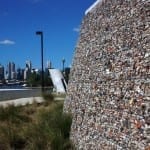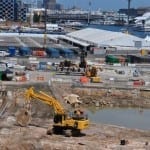As the topic of environmental sustainability continues to dominate current trends in urban planning and development, it seems an appropriate time to reiterate the importance of our commitment, as landscape professionals, to the best practice of locally sourced materiality across our projects.
For developers possessing a strong empathy with environmental concerns, and who seek to underline their own commitment to creating places which are not only iconic and liveable, but which also tread lightly from an ecological perspective, one of the most effective approaches is to insist on locally or regionally sourced construction materials across all areas of their projects – particularly the landscape component. What defines a product as ‘local’ will vary according to the type and availability.
Arcadia has recently been involved with several high profile projects which have been awarded Greenstar accreditation, not least the Shout Ridge residential precinct in Lindfield with Defence Housing Australia and Architectus.
The Crimson Hill development, including Shout Ridge, has achieved the maximum six leaves under the EnviroDevelopment certification by the Urban Development Institute of Australia. Shout Ridge is also aiming for a 5-star design rating with the Greenstar system, which is a strong indicator of the high level of building sustainability. Working with dedicated ESD (Environmentally Sensitive Design) consultants Cundall, the specification of local materials has played a significant role in this ‘feather in the cap’ for DHA.
The boost that this gives to the marketability of the development, its positioning in the market, vis-a-vis the more discerning and environmentally aware buyer, cannot be understated.Whilst limiting potential suppliers will reduce the range of competition for the tendering and potentially result in a slight cost premium for the materials, the benefits of staying local are far more extensive. It reduces shipping distances (a cost saving in itself), which significantly plays down the carbon emissions required to get material to the project site. The use of locally sourced seed stock for plant propagation within the landscape contributes to greater site ecological integrity and relevance within the broader context.
An even more important benefit is the contribution that local materials make towards landscape identity – the site will seem to belong within its locality, reinforcing connections and sense of place. A clear example of this is the new Barangaroo Headland Park (for Nick’s sneak peak, click here!),which, similarly to the nearby Ballast Point Park, had a particular focus on relevance to the site, its history, landscape character, bioregion, and cultural significance. Both of these landscapes went a step further in re-using material found or quarried on site, whether it be sandstone blocks for Barangaroo’s reconstructed shoreline or Ballast Point’s crushed rubble gabions. The outcomes were the same – a strong local aesthetic which links these two sites intrinsically to the wider Sydney landscape context.






